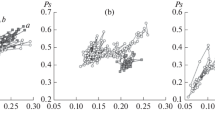Abstract
Rearrangements of the temporal organization of the EEG pattern wave structure were studied in 68 subjects who stayed in the Pamir Mountains at an altitude of 3600 m above sea level for one month. The rearrangement of the EEG pattern proceeds through the following stages: (a) a drastic increase in the probability of interaction of α components accompanied by a decrease in wave interactions in the θ and Δ ranges during the first day of adaptation; (b) a decrease in the probability of interaction of α components accompanied by an increase in the probability of interaction with θ and Δ components on the seventh to ninth days; (c) an increase in the probability of interaction with α components in the occipital leads and a high probability of interaction of all EEG components with θ components in the temporal and frontal regions on the 14th to 16th days; (d) a second decrease in the probability of interaction with α components accompanied by an increase in the interactions with the θ- and Δ frequency ranges in subjects with medium or low plasticity (groups II and III, respectively) of neurodynamic processes and a normalization of interaction of α components in subjects with high plasticity (group I) on the 21st to 23rd days; and (e) completion of the adaptive rearrangement of the pattern of interactions between EEG components in group I and, partly, group II subjects and a decrease in the probability of interaction with the α components accompanied by an increase in interaction with θ components in group III subjects on the 28th to 30th days of adaptation. The results of the study indicate a higher adaptability to high-altitude hypoxia in subjects from groups I and II compared to those from group III. These factors should be taken into account when selecting specialists for work in the mountains.
Similar content being viewed by others
REFERENCES
Vilenskaya, E.M., The Effect of Obsidan on Brain Bioelectric Activity in Healthy Humans under the Conditions of High-Altitude Hypoxia, Zdravookhr. Kirgiz., 1979, no. 1, p. 26.
Kayumov, L.Yu., Human EEG in Chronic Hypoxia, Fiziol. Chel., 1986, vo. 12, no. 6, p. 900.
Malkin, V.B. and Gippenreiter, E.B., Ostraya i khronicheskaya gipoksiya (Acute and Chronic Hypoxia), Moscow: Nauka, 1977.
Malkin, V.B. and Kayumov, L.Yu., Prognostic Signifi-cance of EEG for Estimating Individual Resistance of Humans to Acute Hypoxia, in Otsenka i prognozirovanie funktsional'nykh sostoyanii v fiziologii (Estimation and Prognosis of Functional States in Physiology) (Proc. All-Union Conference), Frunze: Ilim, 1980, p. 195.
Soroko, S.I. and Dimarov, R.M., Individual Characteristics of Cerebral Bioelectric Activity and Hemodynamics in Humans Exposed to Experimental High-Altitude Hypoxia, Fiziol. Chel., 1994, vol. 20, no. 6, p. 16.
Tynalieva, B.K., Relationships between the Parameters of the Bioelectric Activity of the Human Cerebral Cortex and Functional Characteristics of the Autonomic Nervous System in Highlands, Abstract of Cand. Sci. (Med.) Dissertation, Frunze, 1990.
Soroko, S.I., Bekshaev, S.S., and Sidorov, Yu.A., Osnovnye tipy mekhanizmov samoregulyatsii mozga (The Main Types of Brain Self-Regulation Mechanisms), Leningrad: Nauka, 1990.
Soroko, S.I. and Bekshaev, S.S., The Statistical Structure of EEG Rhythm Interaction and Individual Characteristics of Brain Self-Regulation Mechanisms, Fiziol. Zh. SSSR, 1981, vol. 67, p. 1765.
Basaker, R. and Saati, T., Konechnye grafy i seti (Finite Graphs and Networks), Moscow, 1974.
Soroko, S.I., Neirofiziologicheskie mekhanizmy individual'noi adaptatsii cheloveka v Antarktide (Neurophysiological Mechanisms of Individual Adaptation of Humans in the Antarctic), Leningrad, 1984.
Shepoval'nikov, A.N., Tsitseroshin, M.N., and Apanasionok, V.S., Formirovanie biopotentsial'nogo polya mozga cheloveka (Formation of the Biopotential Field of the Human Brain), Leningrad: Nauka, 1979.
Gastaut, H., The Brain Stem and Cerebral Electrogenesis in Relation to Consciousness, in Brain Mechanisms and Consciousness, Paris, 1954, p. 249.
Farber, D.A. and Dubrovinskaya, N.V., Cerebral Organization of Cognitive Processes in Preschool Children, Fiziol. Chel., 1997, vol. 23, no. 2, p. 25.
Rozhkov, V.P. and Soroko, S.I., Formation of the Interaction between the Wave Components of the Main EEG Rhythms in Children under Five Years of Age, Fiziol. Chel., 2000, vol. 26, no. 6, p. 5.
Vedeneeva, L.S. and Soroko, S.I., Computer-Aided Classification of Schoolchildren Age Groups According to the Characteristics of the Temporal Organization of the Wave Structural Pattern of EEG, Fiziol. Chel., 1999, vol. 25, no. 4, p. 51.
Soroko, S.I. and Sidorenko, G.V., EEG-markery nervnopsikhicheskikh narushenii i komp'yuternaya diagnostika (EEG Markers of Neuropsychiatric Disorders and Computer Diagnosis), Bishkek: Ilim, 1993.
Author information
Authors and Affiliations
Rights and permissions
About this article
Cite this article
Soroko, S.I., Kurmashev, R.A. & Dzhunusova, G.S. Rearrangements of the Algorithms of Interaction between Wave Components of EEGs in Subjects with Different Mechanisms of Brain Self-Regulation during Adaptation to High Altitudes. Human Physiology 28, 647–656 (2002). https://doi.org/10.1023/A:1021187903396
Issue Date:
DOI: https://doi.org/10.1023/A:1021187903396



